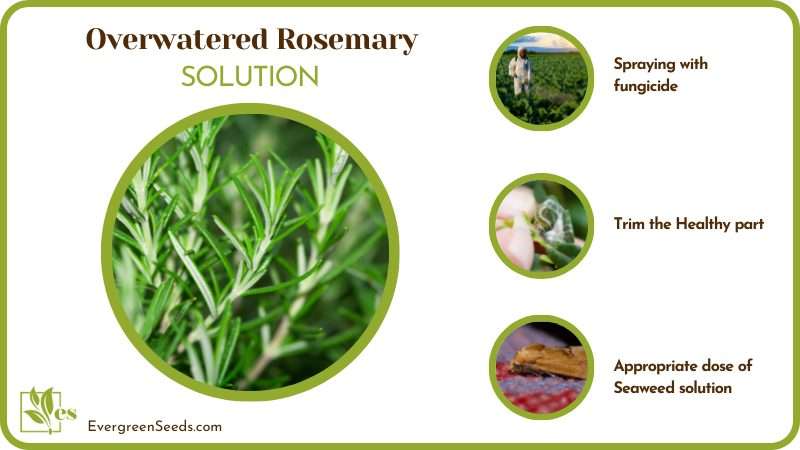Overwatered rosemary plants can be a little intimidating for some gardeners who are unsure about the signs of an overwatered plant. Watering rosemary appropriately can take a little getting used to without having the rosemary plant drying out.

Signs of rosemary drying out could be the rosemary leaves curling, but before we can conclude that a rosemary plant is dying, we need to consider that there are several ways we can revive rosemary plants. The same solutions can be applied to plants that look like a Rosemary.
Whether overwatering or underwatering is the culprit, let’s go over the reasons why our rosemary plants are exhibiting unhealthy symptoms and learn what we can do to alleviate these conditions.
JUMP TO TOPIC
- The Rosemary Plant – An Overview
- How To Tell if Rosemary Is Overwatered
- Can I Revive an Overwatered Rosemary Plant?
- How To Tell if Rosemary Is Underwatered
- What Is the Ideal Soil?
- Can My Rosemary Plant Grow in Low Light Conditions?
- Is the Rosemary Plant Cold-hardy?
- Can I Feed My Rosemary Plant With Fertilizers?
- Is It Okay to Prune This Plant?
- What Are Some Common Problems
The Rosemary Plant – An Overview
Native to the Mediterranean, rosemary plants are low-maintenance, hardy perennials that thrive in well-draining soil, full sunlight and infrequent watering. Grown for its delightful foliage and aromatic flavorful addition to gustatory servings, the humble rosemary plant is every gardener’s dream herb.
With healthful benefits and horticultural value, the rosemary plant can often be found in gardens where growers carefully pluck the silvery-green leaves for their own culinary uses. In pots or in the ground, the rosemary is easy to grow, resistant to disease, and tolerant to mild light and temperature fluctuations.
– Uses of the Rosemary Plant
The rosemary is a wonderful plant, perfect as an ornamental and better when grown as a culinary herb. The deep, woody, spicy scent of the leaves enhance the flavors of various meats, vegetables, and dairy products. The essential oil of the rosemary plant has been valued for centuries due to its many healthy benefits.
Known to be rich in antioxidants and inflammatory compounds, the rosemary plant has been studied extensively. The plant’s properties have been shown to help boost the immune system, as well as improve blood circulation.
With these in mind, let’s tackle some of the most persistent questions we know you have about taking care of the rosemary plant.

How To Tell if Rosemary Is Overwatered
Overwatering the rosemary plant is one of the most common missteps that gardeners can commit – even experienced growers! We have to understand how the rosemary plant grows in order to keep it healthy and alive.
The root system of the rosemary plant can be quite sensitive to excess water, especially when planted in heavy clay soils that hold a lot of moisture. Overwatering can result in blackened leaf tips, which slowly spread to the whole leaf toward the stem. Later, these blackened parts will wilt, and eventually, the whole plant perishes.
Overwatered rosemary plants are easy to recognize aside from the blackened parts of the plant. These parts will often be soft and soggy to the touch. Some overwatered rosemary plants emit a strong pungent smell of decay due to the fungal infection that may have already started to grow in the plant’s root system.
Can I Revive an Overwatered Rosemary Plant?
Depending on the severity, it is definitely possible to revive an overwatered rosemary plant. In order to do this, the first thing to check is the plant’s root system. If the root system is totally black and soft, then reviving the rosemary plant is no longer an option.
However, if there are still some roots that remain strong and healthy, it is still possible to revive the plant.
– How To Revive
The blackened parts of the rosemary plant should immediately be removed. These blackened parts have fungal infections so the healthy plant should be lightly sprayed with a fungicide to discourage future growths. The discarded blackened parts should also be sprayed with a fungicide to ensure that it does not infect other plants.
The trimmed healthy part of the overwatered rosemary plant may now be planted in well-draining soil and allowed to slightly dry out before being watered again.
The well-draining topsoil must be dry for the first one to two inches before the plant can be watered again. This is to ensure that the root system gradually readjusts to becoming healthy once more.
Some gardeners have found that adding an appropriate dose of seaweed solution can help repair roots and encourage root growth.
How To Tell if Rosemary Is Underwatered
Rosemary plants can succumb to underwatering as easily as they can suffer from overwatering. This can be indicated by the leaves turning yellow and eventually wilting. While overwatering produces soft leaves, underwatering creates dry leaves and dry out the rosemary plant.
Underwatered rosemary plants can be easily remedied by increasing the frequency of watering. While the watering frequency may increase, gardeners should be mindful enough to ensure that the rosemary plant does not experience excessive watering in the process.
What Is the Ideal Soil?
The rosemary plant prefers sandy, quick-draining soil that is normally low in nutrients. This is its most ideal soil condition because the rosemary plant has evolved to thrive in the poor sandy soils of the Mediterranean regions.
Gardeners should refrain from placing the rosemary plant in soils that are rich in clay or soils that retain excessive moisture. Excess and stagnant water exposure can cause the root system of the plant to develop fungal infections such as root rot.
While most plants would not tolerate this condition, the rosemary plant depends on well-draining soil for its overall health. Ideally, the mixture should be 80 percent gardening soil and 20 percent sand.
Can My Rosemary Plant Grow in Low Light Conditions?
Low light conditions can cause the rosemary plant to become unhealthy and produce very little foliage. The rosemary plant may eventually perish if left in low light conditions.
The rosemary plant is accustomed to a lot of sunlight and warmth since it is native to the Mediterranean region. Full sun exposure for 10 to 12 hours is ideal, with the minimum full sun exposure being 6 to 8 hours.
The rosemary should be ideally located in a very sunny spot in gardens that receive full sun exposure. The plant should also be kept away from other plants that can block the sun. When grown indoors, grow lights can help the rosemary plant receive the necessary amount of light to keep it healthy and strong.
Is the Rosemary Plant Cold-hardy?
The rosemary plant tolerates a slight amount of cold and heat fluctuations, but the plant is not cold-hardy. Accustomed to constant warmth and sunlight, the rosemary plant may perish under severe winter conditions.
Some varieties may tolerate cooler temperatures of up to 5 F, but prolonged cold exposure may cause the plant to perish.
Gardeners are advised to check their local climates to see if growing rosemary plants outdoors can be a possibility. If not, the rosemary plant may be grown indoors as long as ideal growing conditions are fulfilled through correct watering, regulated temperature and adequate lighting.
Can I Feed My Rosemary Plant With Fertilizers?
The rosemary plant thrives in quick-draining, nutrient-poor soil similar to its native habitat in the Mediterranean regions. When fed with fertilizers with high levels of nitrogen, the rosemary plant’s root system may experience trauma and display symptoms of root burns such as wilted leaves.

However, light green or yellow leaves indicate a possible lack of fertilizers. Ideally, fertilizers for the rosemary plant should be those designed for leafy crops or herbs. Ensure that the appropriate amount is applied, as the rosemary plant is more aromatic and performs better when the soil is poor.
Is It Okay to Prune This Plant?
The rosemary plant can benefit from occasional pruning, especially during the warm seasonal harvest periods. However, pruning should be limited to only a quarter of the plant’s size. Any more can cause the plant to go into shock, causing it to have difficulty in recovering and being at risk of perishing.
To ensure a healthy pruning practice, gardeners should use clean gardening shears or snips. Harvest fresh leaves and sprigs from the upper part of the plant only. The bottom part should be selectively pruned once a year to encourage bushier growth.
Pruning should be done during the warmer seasons. Any pruning activities done during the cooler months may encourage the rosemary plant to develop premature growth and it may not survive the cold.
What Are Some Common Problems
A healthy rosemary plant is naturally resistant to pests and diseases, although fungal and bacterial infections can still happen. A plant that is stressed due to overwatering or high humidity can be more susceptible to fungal and bacterial infections, as well as to pests.
Root rot and powdery mildew are two of the most common fungal infections that plague the rosemary plant. Powdery mildew can be identified through white powdery spores on all parts of the plants. This condition is due to the plant being exposed to damp conditions and warm temperatures.
Powdery mildew can be treated by ensuring that the plant gets exposed to direct sunlight and good air circulation, as well as by spraying the whole plant with a fungicide or a neem oil solution. Neem oil solutions also act as effective insecticides against pests, which may beset the plant if it becomes unhealthy from other causes.













